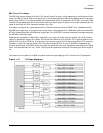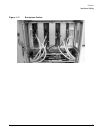
Chapter 1
Overview
Firmware
54
Firmware
The newer Intel Itanium® Processor firmware consists of many components loosely coupled by a single
framework. These components are individually linked binary images that are bound together at run time.
Internally, the firmware employs a software database called a device tree to represent the structure of the
hardware platform and to provide a means of associating software elements with hardware functionality.
The IPF firmware incorporates the following main interfaces:
- Processor Abstraction Layer (PAL) provides a seamless firmware abstraction between the processor, the
system software and the platform firmware
- System Abstraction Layer (SAL) provides a uniform firmware interface and initializes and configures the
platform
- Extensible Firmware Interface (EFI) provides an interface between the OS and the platform firmware
Provides a standard environment for booting by using data tables that contain platform-related information,
boot, and runtime service calls that are available to the operating system and its loader.
The Advanced Configuration and Power Interface (ACPI) provides a new standard environment for
configuring and managing server systems. It moves system configuration and management from the BIOS to
the operating system and abstracts the interface between the platform hardware and the OS software,
thereby allowing each to evolve independently of the other.
The firmware supports HP-UX 11i version 2, Linux, Windows, and OpenVMS through the Itanium®
processor family standards and extensions. It includes no operating systems specific functionality. Every OS
is presented the same interface to system firmware, and all features are available to the OS. One exception to
this is that Windows Server 2003 Datacenter does not support the latest ACPI specification (2.0). The
firmware must provide legacy (1.0b) ACPI tables for that OS. Using the acpiconfig command, the ACPI
tables presented to the operating system are different. The firmware implements the standard Intel
Itanium® Processor family interfaces with some implementation-specific enhancements that the operating
system can use but is not required to use.
User Interface
Itanium® Processor family firmware employs a user interfaces called the Pre-OS system startup environment
(POSSE). The POSSE Shell is based on the EFI Shell. Several commands have been added to the EFI Shell to
support HP value-added functionality. The new commands encompass functionality similar to BCH
commands on PA-RISC machines. However, the POSSE Shell is not designed to encompass all BCH
functionality. They are separate and distinct interfaces.
Event IDs for Errors and Events
The new system firmware generates event IDs, similar to chassis codes, for errors, events, and forward
progress to the MP through common shared memory. The MP interprets, stores, and reflects these event IDs
back to running partitions. This helps in the troubleshooting process.


















